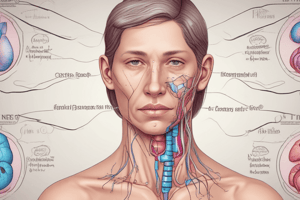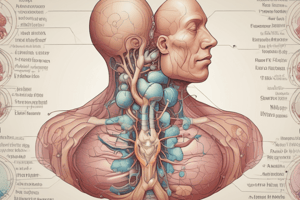Podcast
Questions and Answers
What is the shape of the thyroid gland?
What is the shape of the thyroid gland?
Butterfly-shaped
Which hormones are produced by the thyroid gland?
Which hormones are produced by the thyroid gland?
- Triiodothyronine (T3)
- Tetraiodothyronine (T4)
- Calcitonin
- All of the above (correct)
What role does iodine play in the thyroid gland?
What role does iodine play in the thyroid gland?
It is a building block for thyroid hormones.
Hyperthyroidism is when the thyroid gland is underactive.
Hyperthyroidism is when the thyroid gland is underactive.
Which of the following is a common cause of hyperthyroidism?
Which of the following is a common cause of hyperthyroidism?
Match the following thyroid disorders with their descriptions:
Match the following thyroid disorders with their descriptions:
Calcitonin promotes storage of calcium in ______.
Calcitonin promotes storage of calcium in ______.
What is myxedema?
What is myxedema?
Which procedure is involved in the management of hyperthyroidism?
Which procedure is involved in the management of hyperthyroidism?
Study Notes
Thyroid Gland Anatomy and Physiology
- The thyroid gland is a butterfly-shaped organ located anterior to the trachea and inferior to the larynx.
- It is comprised of two lobes, left and right, connected by an area called the isthmus.
- Parathyroid glands are located on the posterior surface of the thyroid lobes.
- The thyroid gland secretes two main hormones: triiodothyronine (T3) and thyroxine (T4).
- Iodine is a crucial component of thyroid hormones, obtained through diet.
Hypothalamic-Pituitary-Thyroid Axis
- The Hypothalamic-Pituitary-Thyroid Axis involves a complex interplay of hormones.
- The hypothalamus releases thyrotropin-releasing hormone (TRH), which stimulates the pituitary gland to produce thyroid-stimulating hormone (TSH).
- TSH then acts on the thyroid gland to release T3 and T4.
Thyroid Hormone Effects
- T3 and T4 regulate numerous vital body functions, including:
- Growth and development
- Basal metabolic rate
- Heat production
- Metabolism of carbohydrates, proteins, and fats
- Central nervous system function
- Body temperature, heart rate, and blood pressure
- Weight
- Sexual ability
- Calcitonin, another hormone secreted by the thyroid gland, plays a role in calcium regulation:
- Decreases blood calcium levels when elevated
- Promotes calcium storage in bones
- Inhibits calcium reabsorption from renal tubules.
Role of Calcitonin and Parathyroid Hormone (PTH)
- Calcitonin and PTH work together to maintain blood calcium levels within a narrow range.
- Calcitonin lowers blood calcium levels, while PTH raises them.
Thyroid Disorders: Overview and Classifications
- Hyperthyroidism (overactive thyroid): Occurs when the thyroid gland produces excessive thyroid hormones.
- Hypothyroidism (underactive thyroid): Occurs when the thyroid gland does not produce enough thyroid hormones to meet the body's needs.
Causes of Thyroid Disorders
Hyperthyroidism
- Graves' disease: an autoimmune disorder
- Overactive thyroid nodules
- Thyroiditis (inflammation of the thyroid gland)
- Surgical removal of part or all of the thyroid gland
Hypothyroidism
- Hashimoto's disease: an autoimmune disorder
- Thyroiditis
- Congenital hypothyroidism
- Surgical removal of part or all of the thyroid gland
- Pituitary gland tumor
- Radiation treatment of the thyroid
- Thyroid tumor
- Pituitary gland or hypothalamus diseases
Signs and Symptoms of Thyroid Disorders
-
Hyperthyroidism
- Increased metabolism
- Weight loss
- Rapid heartbeat (tachycardia)
- Tremors
- Difficulty sleeping
- Increased appetite
- Heat intolerance
- Nervousness
- Irritability
- Goiter (enlarged thyroid gland)
- Eye problems (bulging eyes)
- Diarrhea
- Hair loss
- Menstrual irregularities
-
Hypothyroidism
- Fatigue
- Weight gain
- Slow heartbeat (bradycardia)
- Constipation
- Dry skin
- Cold intolerance
- Depression
- Memory problems
- Hoarse voice
- Goiter (enlarged thyroid gland)
- Irregular menstrual periods
- Infertility
- Muscle weakness
- Joint stiffness
Complications of Thyroid Disorders
-
Hyperthyroidism
- Thyroid storm: a rare but life-threatening complication characterized by extreme hyperthyroidism symptoms.
-
Hypothyroidism
- Myxedema: a severe form of hypothyroidism that requires immediate medical attention.
Management of Thyroid Disorders
-
Medical
- Antithyroid medications
- Synthetic thyroid hormone replacement therapy
- Beta blockers to manage symptoms
-
Surgical
- Removal of part or all of the thyroid gland (thyroidectomy)
-
Nursing
- Monitoring vital signs
- Education about medication and lifestyle changes
- Assessing for complications
- Providing emotional support
- Teaching self-management skills
Thyroid Storm Management
- Block hormone synthesis (antithyroid drugs)
- Block hormone release (iodine)
- Block T4 to T3 conversion (propranolol, propylthiouracil [PTU])
- Block enterohepatic circulation (cholestyramine)
- Supportive care (fluids, oxygen, and cooling blankets)
Studying That Suits You
Use AI to generate personalized quizzes and flashcards to suit your learning preferences.
Related Documents
Description
Explore the anatomy and physiology of the thyroid gland, including its structure, hormone production, and the hypothalamic-pituitary-thyroid axis. This quiz covers the essential functions of thyroid hormones and their impact on the body.




